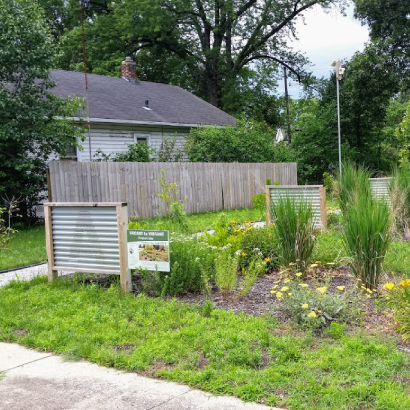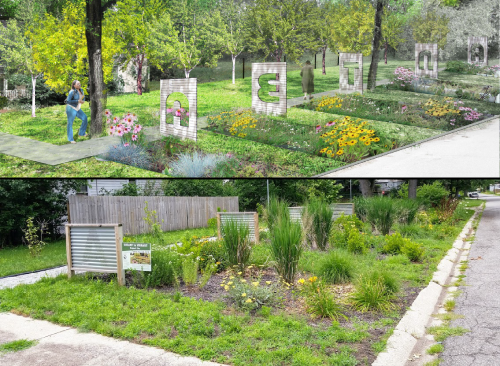
“I have seen and have played a part in my neighborhood developing into a family-friendly place where neighbors know each other and have a vested interest in the neighborhood. We voice our concerns and address issues and the result is that more families have moved in. It’s such a nice feeling to see children playing in the streets, riding bikes, people walking their pets. We have a lot more challenges to overcome, but the neighborhood is the place we call our home!”
—Joelle Gamble, resident of the Aetna neighborhood in Gary, Indiana
Gary, Indiana is situated in the heart of the globally rare dune and swale ecosystem on the southern end of Lake Michigan, about 25 miles from downtown Chicago and just west of the Indiana Dunes National Lakeshore. Gary is home to two low-banked rivers that flow through the city before emptying into Lake Michigan, and several beautiful nature preserves and parks. Gary has many qualities, but it is the people of Gary who are the city’s strongest assets.
Sometimes called The Steel City, Gary was founded by U.S. Steel Corporation in the early 1900’s and developed on drained wetlands. Gary, along with Memphis and Chicago, was the end of the line for many African Americans during the Great Migration. Many legendary Jazz and Blues artists, including the Jackson Five, came out of Gary. Today, the people of Gary are committed to their city. Like Joelle, many residents put time and care into figuring out how to make it even better.
Residents Lead the Way
At the Alliance for the Great Lakes, we work fulltime to protect Great Lakes water and communities, but we know that no one knows their community, their piece of the shore, better than residents themselves. We believe that everyone in the Great Lakes region should benefit from safe, clean water and all the lakes have to offer. Our engagement strategy focuses on elevating the expertise and excitement that residents bring to revitalizing their neighborhood. With the generous support of a Community Engagement Grant through the National Recreation and Park Association (NRPA) and Southwest Airlines, the Alliance is able to lead this community engagement process for the Vacant-to-Vibrant program in Gary, Indiana.
The first step in our place-based engagement process is understanding the needs and opportunities unique to the communities we serve. Gary, like many legacy cities, is developing land re-use strategies that reduce stress on aging infrastructure and creative positive neighborhood changes that benefit residents. The City of Gary has put together a multi-faceted strategy to begin addressing these issues. One piece of the plan is the adoption and scaling-up of the Vacant-to-Vibrant program, which uses resident expertise and nature-based solutions to transform vacant lots into beautifying pocket parks. Gary received federal Hardest Hit Funds to begin implementing some land re-use strategies, which includes demolishing abandoned buildings, replacing six feet of clean topsoil, and installing beautifying pocket parks throughout Gary.
Over the past year, the Alliance’s partnership with the city has focused on supporting resident leadership and ensuring resident expertise is driving the City’s site selection, design, and implementation process as the City of Gary and residents work together to develop community based programs necessary for ongoing use and maintenance of the installed Vacant-to-Vibrant sites.
Grassroots Community Engagement
The project kicked off at district meetings where attendees were introduced to the project and provided an opportunity to become members of the Steering Committee. The Steering Committee included residents, city staff, landscape architects, planners, ecologists and engineers. The role of the Steering Committee was to set and meet the identified goals, provide feedback on the facilitation strategies and materials, and get the word out to ensure Gary residents have an opportunity to participate in the decision-making process.
The identified goal of the facilitation strategies is for residents to decide where and what type of Vacant-to-Vibrant installations should be implemented in their neighborhood. The goals of the Vacant-to-Vibrant installations are neighborhood stabilization and stormwater management. In preparation for the site selection meeting in late July, the Steering Committee provided feedback on community engagement tools like the site selection maps, surveys, outreach materials, and contact list.
One of the key facilitation tools developed to aid residents in the site selection process were maps of potential sites. The Steering Committee narrowed down the list of potential sites based on two primary factors - the amount of vacancy near the potential site and the potential for community involvement in maintaining the site. For example, sites on blocks with excessive vacancy were not included; conversely, sites where there was only one vacancy on an otherwise completely stable block were not included. Sites near community anchors such as active churches, schools, and commercial corridors were ranked higher than those without. The prioritized sites were mapped, and large format maps were printed for the resident site selection meeting.
The resident site selection meeting was held on July 21, and at this meeting approximately 25 residents and Steering Committee members decided which sites they wanted to see transformed into vibrant, lot-sized parks. Attendees filled out surveys, engaged in a conversation about the goals of the project, gathered around maps of their neighborhoods, considered potential sites, and decided with their neighbors which sites were a priority for installation. While there was good residential turn-out for some neighborhoods, there was less turn out for others. A next step is working with community groups and elected officials from the under-represented neighborhoods to ensure residents have an opportunity to provide the needed feedback.
Over the next couple of months, the Steering Committee will help guide the development of design templates and the facilitation strategy needed for the upcoming design charrette. At the design charrette residents, especially those who live close to the selected sites, will use the design templates to decide what type of Vacant-to-Vibrant project will be installed.

Looking Ahead
Even a small project, on just one lot, can have a positive impact on a neighborhood, and while these projects are small, they are scalable. As the city scales up the Vacant-to-Vibrant approach, Gary has an exciting opportunity to amplify these important gains. With strong partnerships and the development of grassroots leadership throughout the process, the transformative effect can extend beyond plots of land and make a lasting impact on the lives of residents and the cities they call home.
The Alliance for the Great Lakes was one of three organizations nationwide selected by the National Recreation and Park Association (NRPA) and Southwest Airlines to receive a $10,000 Community Engagement Grant that is being used to support the Alliance’s community engagement around the Vacant-to-Vibrant program in Gary, Indiana. This grant program is part of NRPA’s Great Urban Parks Campaign, which aims to improve environmental and social outcomes in underserved communities through green stormwater infrastructure projects in local parks.
Read the other blogs in the Community Engagement Series:
- How We Are Transforming Contaminated Land into Natural Oasis through Community Engagement
- Building Relationships to Foster Engagement in the Environment
Angela Larsen is the Community Planning Director at the Alliance for the Great Lakes.

